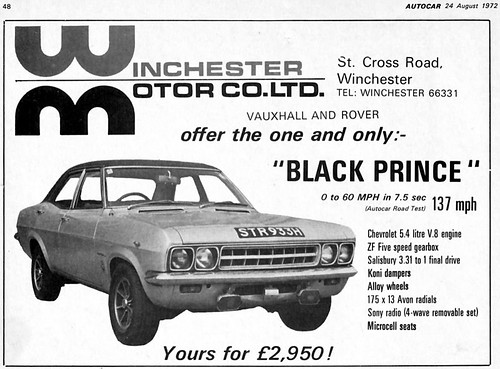
So I posted it up on Retro-Rides, and AlistairK came up with plenty of information about it:
The Black Prince was built for Vauxhall by Gordon Keeble sports cars on a new FD Venotra body in 1971 as a proof of concept. It used a 327 Chevy corvette engine (near enough 5.3 litres) 4 barrel carb high comp etc as used in the Corvette really. This was backed with a ZF 5 speed gearbox, the same type as fitted to certain Aston Martins apparently. A different final drive and limited slip diff was used, although in the stock Ventora case. A bunch of special features were added, including a Sony 4 band radio which was removable from the dash and usable as a portable radio, aux dials, Lucas Square 8 fog lights, a matt black bonnet, dash mounted ice detector, map lights and some other goodies. The Vauxhall "Griffin" badges were replaced with Gordon Keeble's tortoise logo.
Rumour has it that they also built one with an automatic trans. This comes from a contemporary road test which claims that Gordon Keeble had an auto one under constrution at the time the magazine tested the manual one. However no other reliable source claims a second car was built. I knew a guy at Vauxhall who worked there at the time claimed the second car was called The Black Princess.
I doubt Vauxhall ever intended these cars for production as why do a trial V8 car in a model which by then was already scheduled to be dropped in favour of the FE range launched in February 1972?
Vauxhall did do a V8 FE (6 or 8 were built) these were badged up as Viscounts and were killed off by the fuel crisis. They used a 4.4 Holden supplied V8 and that's the reason Big Bertha was built, originally it was intended to race that to promote the FE Viscount...
As for the Black Prince FD. It was broken up in about 1989 by a guy who wanted to use the running gear in a Cobra kit car.
Shame. He'd had it running on the road before and I spoke to the guy's nephew who remembers it doing big ol' wheelspins up the road with smoke coming off both back tyres the length of the street. I think he was the guy who bought it off the advert I assume is in this thread (pics not working for me) or maybe it was his dad who'd bought it - I forget.




